List of mammals of Slovakia
This is a list of the mammal species recorded in Slovakia. There are 77 mammal species in Slovakia, of which 0 are critically endangered, 1 is endangered, 7 are vulnerable, and 4 are near-threatened.[1]
The following tags are used to highlight each species' conservation status as assessed by the IUCN:
| EX | Extinct | No reasonable doubt that the last individual has died. |
| EW | Extinct in the wild | Known only to survive in captivity or as a naturalized populations well outside its previous range. |
| CR | Critically endangered | The species is in imminent risk of extinction in the wild. |
| EN | Endangered | The species is facing an extremely high risk of extinction in the wild. |
| VU | Vulnerable | The species is facing a high risk of extinction in the wild. |
| NT | Near threatened | The species does not meet any of the criteria that would categorise it as risking extinction but it is likely to do so in the future. |
| LC | Least concern | There are no current identifiable risks to the species. |
| DD | Data deficient | There is inadequate information to make an assessment of the risks to this species. |
Some species were assessed using an earlier set of criteria. Species assessed using this system have the following instead of near threatened and least concern categories:
| LR/cd | Lower risk/conservation dependent | Species which were the focus of conservation programmes and may have moved into a higher risk category if that programme was discontinued. |
| LR/nt | Lower risk/near threatened | Species which are close to being classified as vulnerable but are not the subject of conservation programmes. |
| LR/lc | Lower risk/least concern | Species for which there are no identifiable risks. |
Subclass: Theria
Infraclass: Eutheria
Order: Rodentia (rodents)
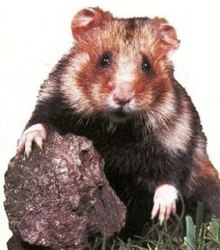

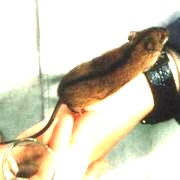
Rodents make up the largest order of mammals, with over 40 percent of mammalian species. They have two incisors in the upper and lower jaw which grow continually and must be keep short by gnawing. Most rodents are small though the capybara can weigh up to 45 kg (100 lb).
- Suborder: Sciurognathi
- Family: Castoridae (beavers)
- Genus: Castor
- European beaver Castor fiber NT
- Genus: Castor
- Family: Sciuridae (squirrels)
- Subfamily: Sciurinae
- Tribe: Sciurini
- Genus: Sciurus
- Red squirrel Sciurus vulgaris NT
- Genus: Sciurus
- Tribe: Sciurini
- Subfamily: Xerinae
- Tribe: Marmotini
- Genus: Marmota
- Alpine marmot Marmota marmota LR/lc
- Genus: Spermophilus
- European ground squirrel Spermophilus citellus VU
- Genus: Marmota
- Tribe: Marmotini
- Subfamily: Sciurinae
- Family: Gliridae (dormice)
- Subfamily: Leithiinae
- Genus: Dryomys
- Forest dormouse Dryomys nitedula LR/nt
- Genus: Eliomys
- Garden dormouse Eliomys quercinus VU
- Genus: Muscardinus
- Hazel dormouse Muscardinus avellanarius LR/nt
- Genus: Dryomys
- Subfamily: Glirinae
- Genus: Glis
- Edible dormouse Glis glis LR/nt
- Genus: Glis
- Subfamily: Leithiinae
- Family: Dipodidae (jerboas)
- Subfamily: Sicistinae
- Genus: Sicista
- Northern birch mouse Sicista betulina LR/nt
- Southern birch mouse Sicista subtilis LR/nt
- Genus: Sicista
- Subfamily: Sicistinae
- Family: Cricetidae
- Subfamily: Cricetinae
- Genus: Cricetus
- European hamster Cricetus cricetus LR/lc
- Genus: Cricetus
- Subfamily: Arvicolinae
- Genus: Arvicola
- Water vole Arvicola terrestris LR/lc
- Genus: Chionomys
- Snow vole Chionomys nivalis LR/nt
- Genus: Clethrionomys
- Bank vole Clethrionomys glareolus LR/lc
- Genus: Microtus
- Field vole Microtus agrestis LR/lc
- Common vole Microtus arvalis LR/lc
- Tundra vole Microtus oeconomus LC
- European pine vole Microtus subterraneus LR/lc
- Tatra vole Microtus tatricus LR/nt
- Genus: Arvicola
- Subfamily: Cricetinae
- Family: Muridae (mice, rats, voles, gerbils, hamsters, etc.)
- Subfamily: Murinae
- Genus: Apodemus
- Striped field mouse Apodemus agrarius LR/lc
- Yellow-necked mouse Apodemus flavicollis LR/lc
- Wood mouse Apodemus sylvaticus LC
- Ural field mouse Apodemus uralensis LR/lc
- Genus: Mus
- Steppe mouse Mus spicilegus LR/nt
- Genus: Apodemus
- Subfamily: Murinae
- Family: Castoridae (beavers)
Order: Lagomorpha (lagomorphs)

The lagomorphs comprise two families, Leporidae (hares and rabbits), and Ochotonidae (pikas). Though they can resemble rodents, and were classified as a superfamily in that order until the early 20th century, they have since been considered a separate order. They differ from rodents in a number of physical characteristics, such as having four incisors in the upper jaw rather than two.
- Family: Leporidae (rabbits, hares)
- Genus: Oryctolagus
- European rabbit Oryctolagus cuniculus LR/lc
- Genus: Lepus
- European hare Lepus europaeus LR/lc - approximately 203,000 individuals in 2008 according to the Hunting statistics, other sources claim 177,747 individuals at the end of 2011, 13,219 individuals were killed during 2011.
- Genus: Oryctolagus
- Family: Leporidae (rabbits, hares)
Order: Soricomorpha (shrews, moles, and solenodons)


The "shrew-forms" are insectivorous mammals. The shrews and solenodons closely resemble mice while the moles are stout-bodied burrowers.
- Family: Soricidae (shrews)
- Subfamily: Crocidurinae
- Genus: Crocidura
- Bicolored shrew Crocidura leucodon LR/lc
- Greater white-toothed shrew Crocidura russula LC
- Lesser white-toothed shrew Crocidura suaveolens LR/lc
- Genus: Crocidura
- Subfamily: Soricinae
- Tribe: Nectogalini
- Genus: Neomys
- Southern water shrew Neomys anomalus LR/lc
- Eurasian water shrew Neomys fodiens LR/lc
- Genus: Neomys
- Tribe: Soricini
- Genus: Sorex
- Alpine shrew Sorex alpinus LR/lc
- Common shrew Sorex araneus LR/lc
- Eurasian pygmy shrew Sorex minutus LR/lc
- Genus: Sorex
- Tribe: Nectogalini
- Subfamily: Crocidurinae
- Family: Soricidae (shrews)
Order: Chiroptera (bats)
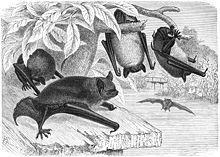
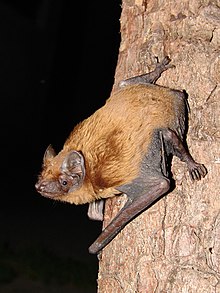
The bats' most distinguishing feature is that their forelimbs are developed as wings, making them the only mammals in the world naturally capable of flight. Bat species account for about 20% of all mammals.
- Family: Vespertilionidae
- Subfamily: Myotinae
- Genus: Myotis
- Bechstein's bat Myotis bechsteini VU
- Brandt's bat Myotis brandti LR/lc
- Pond bat Myotis dasycneme VU
- Daubenton's bat Myotis daubentonii LR/lc
- Geoffroy's bat Myotis emarginatus VU
- Greater mouse-eared bat Myotis myotis LR/nt
- Whiskered bat Myotis mystacinus LR/lc
- Natterer's bat Myotis nattereri LR/lc
- Genus: Myotis
- Subfamily: Vespertilioninae
- Genus: Barbastella
- Barbastelle Barbastella barbastellus VU
- Genus: Eptesicus
- Northern bat Eptesicus nilssoni LR/lc
- Serotine bat Eptesicus serotinus LR/lc
- Genus: Nyctalus
- Greater noctule bat Nyctalus lasiopterus LR/nt
- Lesser noctule Nyctalus leisleri LR/nt
- Common noctule Nyctalus noctula LR/lc
- Genus: Pipistrellus
- Nathusius' pipistrelle Pipistrellus nathusii LR/lc
- Common pipistrelle Pipistrellus pipistrellus LC
- Genus: Plecotus
- Brown long-eared bat Plecotus auritus LR/lc
- Grey long-eared bat Plecotus austriacus LR/lc
- Genus: Vespertilio
- Parti-coloured bat Vespertilio murinus LR/lc
- Genus: Barbastella
- Subfamily: Miniopterinae
- Genus: Miniopterus
- Schreibers' long-fingered bat Miniopterus schreibersii LC
- Genus: Miniopterus
- Subfamily: Myotinae
- Family: Rhinolophidae
- Subfamily: Rhinolophinae
- Genus: Rhinolophus
- Mediterranean horseshoe bat Rhinolophus euryale VU
- Greater horseshoe bat Rhinolophus ferrumequinum LR/nt
- Lesser horseshoe bat Rhinolophus hipposideros LC
- Genus: Rhinolophus
- Subfamily: Rhinolophinae
- Family: Vespertilionidae
Order: Carnivora (carnivorans)
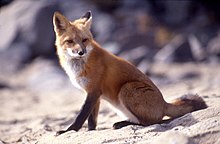


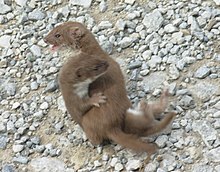
There are over 260 species of carnivorans, the majority of which feed primarily on meat. They have a characteristic skull shape and dentition.
- Suborder: Feliformia
- Suborder: Caniformia
- Family: Canidae (dogs, foxes)
- Genus: Vulpes
- Red fox Vulpes vulpes LC
- Genus: Canis
- Golden jackal Canis aureus LC
- Gray wolf Canis lupus LC - estimates range from 130 individuals (environmentalists) through 400 (one international study) to over 1,000 (official Slovak statistics)
- Genus: Vulpes
- Family: Ursidae (bears)
- Genus: Ursus
- Brown bear Ursus arctos LR/lc - estimates range from 500 individuals (biology experts) through 800 (Slovak Ministry of Environment) to 1,483 (official Slovak statistics)[2]
- Genus: Ursus
- Family: Mustelidae (mustelids)
- Genus: Mustela
- Stoat Mustela erminea LR/lc
- Steppe polecat Mustela eversmannii LR/lc
- European mink Mustela lutreola EN
- Least weasel Mustela nivalis LR/lc
- European polecat Mustela putorius LR/lc
- Genus: Martes
- Beech marten Martes foina LR/lc
- Pine marten Martes martes LR/lc
- Genus: Meles
- Eurasian badger Meles meles LR/lc - approximately 7,300 individuals in 2011 according to the Hunting statistics
- Genus: Lutra
- European otter Lutra lutra NT
- Genus: Mustela
- Family: Canidae (dogs, foxes)
Order: Artiodactyla (even-toed ungulates)
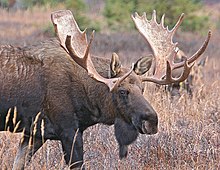
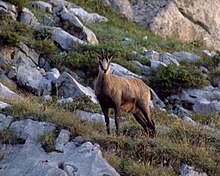
The even-toed ungulates are ungulates whose weight is borne about equally by the third and fourth toes, rather than mostly or entirely by the third as in perissodactyls. There are about 220 artiodactyl species, including many that are of great economic importance to humans.
- Family: Suidae (pigs)
- Family: Cervidae (deer)
- Subfamily: Cervinae
- Genus: Cervus
- Red deer Cervus elaphus LR/lc - As of the end of 2011, there were 58,106 individuals, during 2011 22,157 individuals were killed, 83 captured and 1,534 died naturally.
- Genus: Dama
- Fallow deer Dama dama - As of the end of 2011, there were 12,831 individuals, during 2011 4,984 individuals were killed, 154 captured and 255 died naturally.
- Genus: Cervus
- Subfamily: Capreolinae
- Subfamily: Cervinae
- Family: Bovidae (cattle, antelope, sheep, goats)
- Subfamily: Caprinae
- Genus: Rupicapra
- Chamois Rupicapra rupicapra LR/lc - As of the end of 2011, there were 931 individuals, during 2011 9 individuals were killed.
- Rupicapra rupicapra rupicapra (Linnaeus, 1758) - in Veľká Fatra and Slovenský raj, together 186 individuals.
- Rupicapra rupicapra tatrica (Blahout, 1972) - in High Tatras and Low Tatras, together 745 individuals.
- Chamois Rupicapra rupicapra LR/lc - As of the end of 2011, there were 931 individuals, during 2011 9 individuals were killed.
- Genus: Ovis
- Mouflon Ovis musimon - As of the end of 2011, there were 13,883 individuals, during 2011 4,353 individuals were killed.
- Genus: Rupicapra
- Subfamily: Caprinae
See also
- List of chordate orders
- List of regional mammals lists
- List of prehistoric mammals
- Mammal classification
- New mammal species
Notes
- ^ This list is derived from the IUCN Red List which lists species of mammals and includes those mammals that have recently been classified as extinct (since 1500 AD). The taxonomy and naming of the individual species is based on those used in existing Wikipedia articles as of 21 May 2007 and supplemented by the common names and taxonomy from the IUCN, Smithsonian Institution, or University of Michigan where no Wikipedia article was available.
- ^ Piško, Michal (6 June 2007). "Medvede čaká lov (Hunting awaits the bears)". SME. Retrieved 7 May 2012.
References
- "The IUCN Red List of Threatened Species: Mammals of Slovakia". IUCN. 2001. Retrieved 22 May 2007. [dead link]
- "Mammal Species of the World". Smithsonian National Museum of Natural History. 2005. Archived from the original on 27 April 2007. Retrieved 22 May 2007.
{{cite web}}: Unknown parameter|deadurl=ignored (|url-status=suggested) (help) - "Animal Diversity Web". University of Michigan Museum of Zoology. 1995–2006. Retrieved 22 May 2007.
